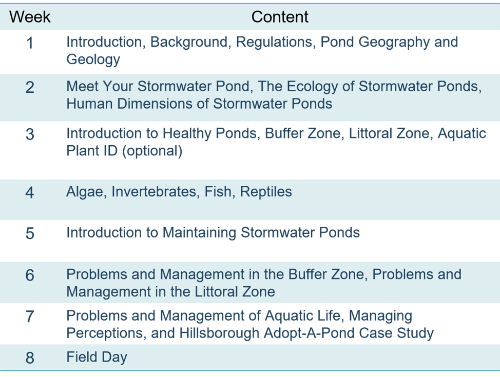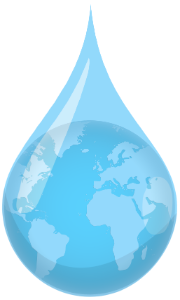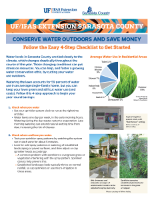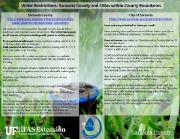
Healthy Ponds
In this section...
- Healthy Ponds Collaborative
- Healthy Ponds Certification Program
- What is a Healthy Pond?
- Healthy Ponds and You!
Healthy Ponds Collaborative
The Healthy Pond Collaborative, funded by the Charles & Margery Barancik Foundation, is a three-year initiative to enhance water quality in Sarasota County. The Collaborative includes UF/IFAS Extension Sarasota County, Solutions to Avoid Red Tide (START), the Sarasota County Neighborhood Environmental Stewardship Team (NEST) Program, the Science and Environment Council of Southwest Florida, and hopefully you!
Want to join the Collaborative? There are a few requirements. Contact Mollie Holland at mkholland@scgov.net with any questions and to learn more about the program.
Requirements for joining the Healthy Pond Collaborative:
- Have the ability and capacity to sustain pond enhancement strategies.
- Have a shallow area that would enable aquatic plants to grow.
- Your neighborhood ponds exist within a watershed that is impacted by nutrient pollution.
- Must be able to establish a buffer zone/no mow zone.
- Are interested in creating a long-term pond management plan.
A quick summary of our project includes:
- Provide grants to neighborhoods grants for plant stock between $1,000 to $5,000. And create model ponds that are in highly visible public locations like public parks and golf courses.
- Create a citizen how-to guide for managing healthy stormwater ponds
- Develop a neighborhood communications tool kit created using the successful strategies of local water champions -- https://www.scienceandenvironment.org/project/hoa/
- Monitor water chemistry
Together we can save our bays!
Healthy Ponds Certification Program
A professional course for the pond professional. Click here for course offerings.
The Healthy Ponds Certification program is a self-paced, 8-week online course that culminates with a 4-hour, in-person field day. Course participants can earn up to 21 Pesticide Applicator’s License CEU credits. See the CEU credit table and course outline posted below for more information.
Available CEU Credits
|
Pesticide Applicators CEUs Pending |
NUMBER OF CREDITS |
|
Aquatic (core) |
4 |
|
Aquatic (category) |
16 |
|
Natural Areas |
5 |
|
Total CEUs allowable |
25 |
Healthy Ponds Certification Program Schedule

What is a Healthy Pond?
A healthy pond has five main features.
Features of a healthy pond:
- Florida native plants in and around the pond, covering 30-85% of the total pond area.
- Diverse plants and animals supporting a balanced aquatic ecosystem.
- A 3-to-10-foot-wide buffer zone with plants growing their maximum height and turfgrass trimmed to maintain 8 – 12 inches in height.
- Periphyton allowed to grow.
- Limited stressors from surrounding roadways and yards.
The first is an abundance of native flora in and around the pond, covering between 30% and 85% of the pond area. This is necessary to help support a balanced ecosystem of fish, invertebrates, birds, and more. Second, when selecting plants for your pond, it is important to have a variety of species to encourage biodiversity. Biodiversity creates resilience in the face of disease and other natural hazards and ensures shoreline stability.
Another feature of healthy stormwater ponds is a buffer zone that is greater than 3-feet-wide. Buffer zones prevent erosion, which can cost communities hundreds of thousands of dollars to fix. Thus, buffer zones (sometimes called no mow zones) extend the life the pond, delaying and possibly putting off the need for expensive engineered solutions. In addition to saving money, buffer zones also reduce pollutants coming from adjacent yards and provide habitat for Florida wildlife. Not all buffer zones are created equal. That is why we have created a buffer zone fact sheet to communicate the pros and cons of 3 different buffer zones.
It is important that the pond managers and residence recognize the importance of periphyton and other beneficial algae. Contrary to the common narrative that "a clear pond is a healthy pond," in our region of the state where nutrients are naturally abundant, the presence of algae, bacteria, and detritus in ponds is an integral part of a healthy ecosystem. These smaller organisms are the base of the food chain and provide necessary nutrition to invertebrates, fish, and birds.
Last, it is important that you minimize the negative inputs coming into your pond from neighborhood yards and streets. These stressors, which include nutrients from landscape debris, fertilizer, and/or pet waste, can create an imbalanced pond and subsequent decline in the health of your pond and all the plants and animals that rely on it.
To learn more about what makes a pond "healthy," check out the postcards and factsheets linked under Resources. Have a stormwater pond at home? You can help evaluate its health by using our buffer and littoral zone scorecards.
Healthy Ponds and You!
A healthy pond starts with you! You can assess your own pond using the Stormwater Pond Assessment tool. You can also request a stormwater pond assessment by contacting us. Finally, you can follow these recommendations to create a healthy pond.
- Know your permit. See how your ponds were designed by finding your Environmental Resource Permit on file at the Water Management District.
-
 Reduce negative inputs. Limit fertilizer and keep grass clippings/landscape debris, pet waste, and irrigation water out of your pond.
Reduce negative inputs. Limit fertilizer and keep grass clippings/landscape debris, pet waste, and irrigation water out of your pond. - Support your pond’s natural food web. Allow native plants to thrive.
- Create a vegetated buffer zone. Separate your yard from the water’s edge with native and Florida-Friendly plants.
- Manage invasive species. Use an integrated pest management (IPM) approach to manage invasive species.
- Reduce herbicide use. Limit chemical applications applied for aesthetic reasons.
Broad-spectrum herbicides, such as copper sulfate, target the items at the bottom of the food chain (algae and plants), but invertebrates in the middle are often more sensitive to these chemicals. Herbicides eliminate or weaken the invertebrate community, destroying the natural pond food chain. Invertebrates feed on algae, plants, and other insect pests. Invertebrates also make food for fish, birds, and other predators. By eliminating non-essential applications of herbicides and reducing the use of broad-spectrum herbicides, you can build up your pond’s food web, which in turn stabilizes the ecosystem and creates a healthier pond.
Resources
- Fact sheet: Stormwater Ponds (PDF)
- Fact sheet: Best Management Practices for Blue-Green Algal Blooms in Ponds (PDF)
- Fact sheet: Buffer Zones for Stormwater Ponds (PDF)
- Postcard: Healthy Ponds and You! (PDF)
- Postcard: Healthy Pond Banks & Buffer Zones (PDF)
- Scorecard: Buffer Zone Scorecard (PDF)
- Scorecard: Littoral Zone Scorecard (PDF)
Learn More
Make the Pledge
- Aerator pledge (PDF)
- Showerhead pledge (PDF)




